Samsung Galaxy S 2 (International) Review - The Best, Redefined
by Brian Klug & Anand Lal Shimpi on September 11, 2011 11:06 AM EST- Posted in
- Smartphones
- Samsung
- Galaxy S II
- Exynos
- Mobile
Battery
Even though it’s almost at the end of our review, battery life is hugely important, and measuring up how SGS2 does compared to the competition is a large part of what makes things pretty positive for the device. As a reminder, we measure battery life by having the browser load through a few dozen pages with brightness set on 200 nits until the phone dies, on both WiFi and cellular (WCDMA). The SGS2 has a capacious 6.11 Whr battery, which is among a small number of devices I’ve seen that come with over a 6 Whr battery by default.

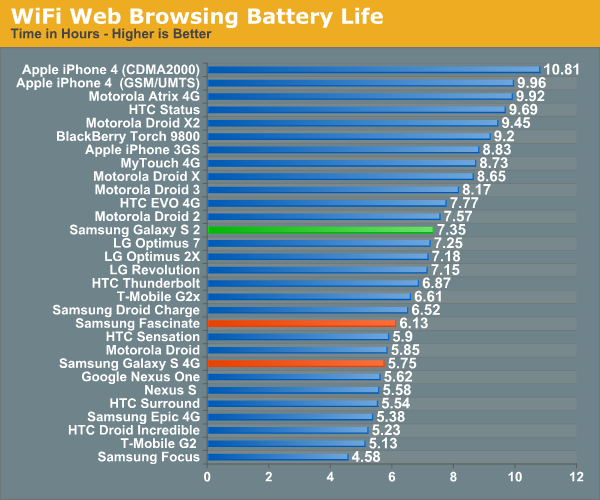
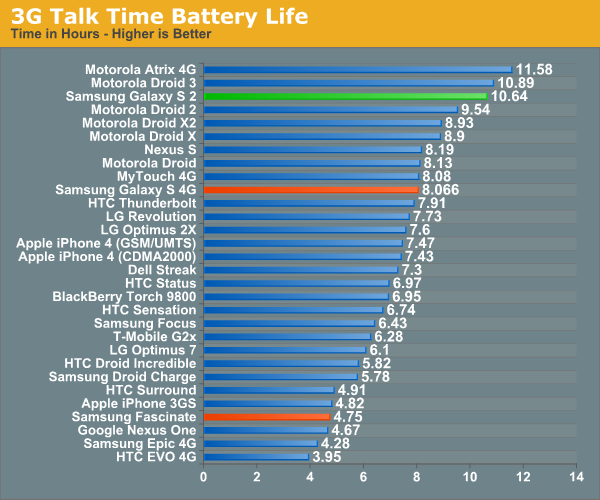
The SGS2 outperforms its predecessors pretty handily, and I’ve highlighted in orange those results from the Galaxy S 4G and Fascinate. When you factor in that SGS 4G has the same capacity 6.11 Whr battery, it’s obvious how much of the gains are both SAMOLED+ efficiency and a dual core SoC.
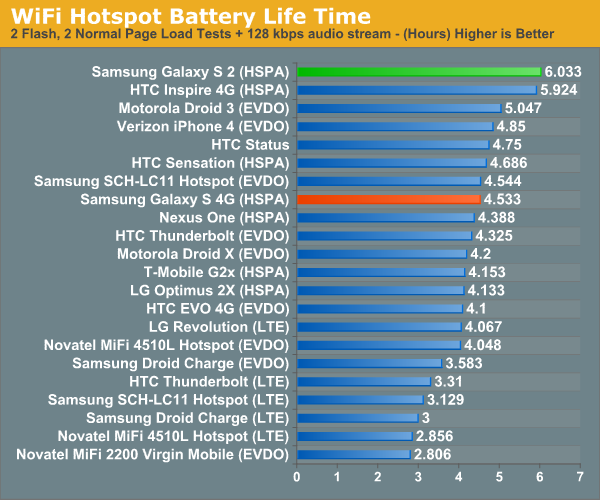
In the WiFi hotspot test, the SGS2 actually trounces everything else I’ve seen thus far as well, edging out the Inspire 4G. As a reminder, that test consists of loading 4 sets of the page load test alongside a 128 kbps MP3 stream with the display off until the phone dies.
The last thing to talk about with respect to battery life is the infamous “AOS Bug,” where AOS references the Android OS line item in the battery use window. I’ve read just about everything there is I could find on this bug, and believe it to just be related to how Android reports this metric based on CPU time that a process and its children use. Some have speculated this is something which has showed up with dual core SoCs. To be completely honest, I don’t put much stock in the line-item breakdown of battery use to begin with, what I look at is the graph view. Either way, the battery numbers above speak for themselves, and SGS2 battery life is definitely superior to the predecessor, AOS issue or not.
Conclusions and Final Thoughts
It’s always difficult to sum up a device like the SGS2, because this is such a major launch and so much has already been written and discovered about the phone. I find myself again thinking back to how long it’s been since we first played with the SGS2 at MWC and just how far the device has come. It literally is a completely different device today than what Anand and I played with chained to a table in Barcelona.
There’s no doubt in my mind that SGS2 is the most powerful smartphone out right now, both in the synthetics and in just subjective feel. That’s thanks in large part to Exynos 4210’s dual core Cortex A9s at 1.2 GHz and ARM’s Mali–400 GPU. The end result is an experience that’s buttery smooth and rarely shows any signs of being want for more power. Mali–400 alone is twice as fast as any other smartphone GPU out right now, and Exynos 4210 seems likely to vie for performance crown in Android-land until the start of 2012.
The original Galaxy S was a hugely popular Android phone, and thankfully the few issues that were around that generation have been ironed out this second time around. The result is a device that is better in almost every category. Battery life is longer than the predecessor. Performance is much higher. Super AMOLED uses the much more readable RGB stripe. GPS works this go around. Camera stills and video are awesome. The list goes on.
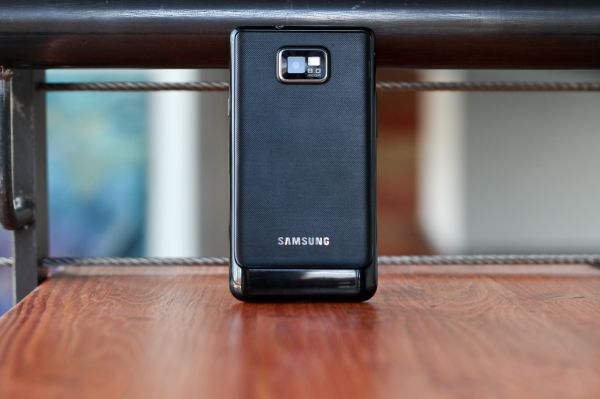
Some Photos Courtesy Sarah Trainor
That said there are still a few lingering areas which the SGS2 wavers. Audio quality from the Yamaha codec in the SGS2 isn’t up to the level of quality the Wolfson was capable of, and there are some potentially frustrating baseband instability issues we ran into as well. There’s also the notable omission of NFC in all but the Korean version of the SGS2, and it looks as though only certain variants coming to the USA will have NFC.
The international market is a whole lot more efficient than the situation we have to deal with here in the USA. Phones launch in largely the form the manufacturer originally intended them to, and as a result there’s a single target for both enthusiast ROM modders and the handset vendor to build and test software on. More and more, it’s really that kind of long-term support that makes a handset valuable, and SGS2 is such a huge success already that it isn’t likely to be obsolete in just a few months, even with Kal-El phones and a new Nexus looming on the horizon.
I really have to admit that I went into this review expecting to be massively underwhelmed with Galaxy S 2. Here we are at the end though, I find my thoughts about the device completely changed. Even taking into account the near term Android roadmap, Galaxy S 2 is the Android smartphone I’d absolutely buy today.



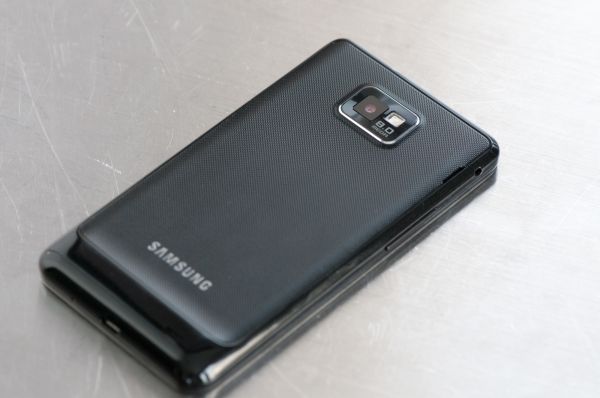








132 Comments
View All Comments
kreacher - Monday, September 12, 2011 - link
I was disappointed to see that there is no mention of the screen 's inability to display 24bit gradients while Samsung claims its a screen capable of displaying 16M colors.supercurio - Monday, September 12, 2011 - link
See my answer for Astri.Maybe you only checked a gradient in Web Browser or a specific app that forces 16bit surfaces.
Each app has the ability to choose how the rendering is done in this regard.
Internally, the Super AMOLED controller works in much more than 24bit in order to proceed to complex color-space conversions between the a digital frame buffer and an analog, very large dynamic range OLEDs.
lemmo - Monday, September 12, 2011 - link
Great review, and incredible detail on the audio quality. Shame the SGS2 has taken a step backwards on audio. Any info on the likely spec for the audio on the Samsung Nexus Prime?Also, any recommendations on reviews of best smartphones for audio quality? cheers :)
supercurio - Monday, September 12, 2011 - link
Thanks for the feedback!I really need it in order to improve next review.
Organize it differently for better readability, maybe evaluate other aspects as well (like recording)
I have no info about what's in Nexus Prime but I'd like to :P
If somebody can send me a report: https://market.android.com/details?id=org.projectv... I'll study it.
Best devices I know in terms of audio quality:
- with Voodoo Sound: Nexus S, Galaxy S family, Galaxy Tab 7".
- with or without Voodoo sound: Asus Transformer
- soon with Voodoo Sound: Galaxy Tab 10.1 (incredible power stage for the headphone amp)
- iPhones/iPad: clean DAC but boring headphone amp (unable to drive many cans to adequate levels)
And.. many I don't know! (yet?)
lemmo - Wednesday, September 14, 2011 - link
Thanks supercurio, very helpful. I'll keep looking for more info on the Nexus Prime.Shame none of the other phones/tablets you mention have got the right spec for me.
In practice, do you think the 'average user' will notice the poorer audio quality on the SGS2?
yellowchilli - Monday, September 12, 2011 - link
a very very good read thank youi've owned the sgs2 since its EU launch..it's interesting to see the slight differences/improvements samsung has put into the US release (e.g. the power button, camera ui)
mcquade181 - Monday, September 12, 2011 - link
I've had my SGS2 here in Australia for two months now and on a recent snow trip noticed some deficiencies compared to my friends Nokia N8. We both use the same provider (Telstra 3G on 850MHz):1. Whilst travelling there were periods where I completely lost reception whereas the N8 still had a signal and was able to make calls. This suggests that the SGS2 is a bit lacking in cellular sensitivity (and note that the N8 is not all that flash either when compared to the old Nokia N95).
2. In our snow accomodation I could not get a reliable WiFi signal from the local hotspot whereas the N8 could (it was marginal, but it did work).
3. Bluetooth on the SGS2 is unreliable with some devices. It keeps disconnecting after a few minutes.
That said I do like my SGS2 and is better in many other ways to the Nokia N8 - in particular earphone volume and call clarity where the N8 is deficient. Of course android has a much wider selection of available apps than does the Nokia, although surprisingly ALL my favourite apps are also available for the Nokia.
Regards from down under, Graham Rawolle.
willstay - Monday, September 12, 2011 - link
What a coincidence. After two Androids, I actually bought N8 and later sold it to get SGS2. Before Belle, swype was only available in landscape and my must-have apps are not there for Symbian.jcompagner - Tuesday, September 13, 2011 - link
yes that is the only drawback i also can find of the SGS2..Wifi reception is really not up to standards.
kmmatney - Monday, September 12, 2011 - link
I'm not happy with the battery tests - they don't show real life usage. I'd still like to know what happens with the battery if you just leave the phone in your pocket for most of the day, or what happens if you leave it in standby overnight. All of my co-workers complain about battery life with their Android phones, and all want to get iPhones the next time around. The batteries seem to drain excessively with the phones doing nothing, and they are often dead when they go to use them. Who cares if you can browse the web for 7 hours or whatever...I just want the phone to be ready to use if its been sitting on my desk for half the day, or if I forget to charge it overnight. This is way more important - at least for someone like me who travels. (actually, I work a lot in wafer fabs around the world, and crappy reception in the fabs often drain battery quickly).I guess it will depend on what Apps are installed, and you use push notifications, but it would be useful to have a test where you charge the phone, and then let it sit for 8 hours doing nothing, and then report the battery life. The older Android phones seemed terrible at this, while my iPhone 3GS is great.
This phone looks awesome, but I would need this information before I would consider buying it.